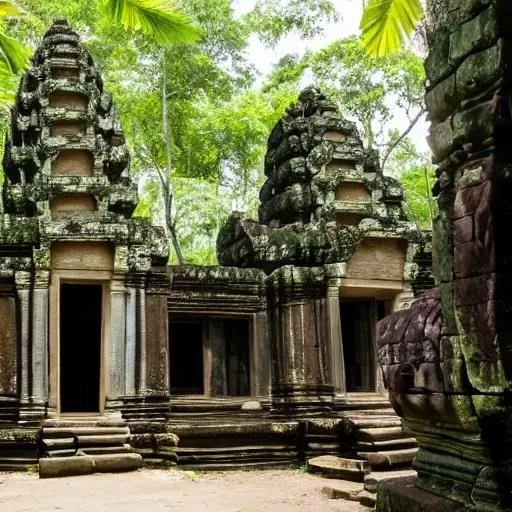
Cambodia, a land steeped in ancient wonders and vibrant contemporary life, beckons travelers with its enigmatic temples, pristine coastlines, and profoundly resilient culture. Yet, for many aspiring adventurers, a crucial question often lingers: when is the optimal moment to embark on this Southeast Asian odyssey? The answer, as discerning globetrotters often discover, is far more nuanced than a simple date on a calendar; it’s about aligning your aspirations with the rhythm of the Kingdom of Wonder. Understanding Cambodia’s distinct climatic seasons is not merely a logistical exercise but an empowering strategic decision, capable of transforming a good trip into an absolutely unforgettable expedition.
Envisioning your ideal Cambodian experience—be it witnessing the majestic sunrise over Angkor Wat, trekking through verdant rice paddies, or simply unwinding on an idyllic island beach—necessitates a thoughtful consideration of the prevailing weather patterns. Each season, with its unique characteristics, presents a different facet of this captivating nation, offering unparalleled opportunities for exploration, relaxation, and cultural immersion. By meticulously planning around these natural cycles, travelers can deftly navigate potential challenges, maximize their enjoyment, and truly connect with the authentic spirit of Cambodia, ensuring a journey that resonates long after returning home.
| Season | Months | Characteristics | Pros for Travelers | Cons for Travelers | Ideal For |
|---|---|---|---|---|---|
| Dry Season | November ⏤ February | Pleasantly warm, low humidity, minimal rainfall. Clear skies and comfortable temperatures (25-30°C). | Optimal weather for extensive temple exploring (Angkor Wat), beach relaxation, and outdoor activities. Vibrant festivals like Bon Om Touk (Water Festival). | Peak tourist season, leading to higher prices for accommodation and flights, larger crowds at major sites. Booking in advance is crucial. | First-time visitors, those seeking comfortable weather, bustling atmospheres, and comprehensive sightseeing. |
| Hot Season | March ⏤ May | Intensely hot, high humidity, increasing chance of short rain showers towards May. Temperatures often exceed 35°C. | Significantly fewer crowds, often leading to lower prices for tours and accommodations. Lush landscapes emerging. Perfect for relaxing by a pool. | Extreme heat can be challenging for extensive outdoor exploration, requiring early starts and frequent hydration. | Budget travelers, those who prefer fewer crowds, can tolerate high temperatures, and enjoy a more relaxed pace. |
| Wet Season | June ⏤ October | Regular, often heavy, afternoon downpours, typically lasting an hour or two. High humidity. Landscapes incredibly lush and vibrant. Temperatures around 25-30°C. | Dramatic photographic opportunities, Tonlé Sap lake at its fullest, allowing for fascinating floating village tours. Fewer tourists, great deals. The countryside is beautifully green. | Muddy roads in rural areas, some activities might be weather-dependent, occasional travel disruptions. Mosquitoes can be more prevalent. | Photographers, nature lovers, budget-conscious travelers seeking an authentic, verdant experience and fewer tourist crowds. |
For more detailed travel information, including visa requirements and health advisories, we recommend visiting the Official Tourism Cambodia Website.
The Dry Season: Cambodia’s Golden Window (November ⏤ February)
Often heralded as the quintessential time to visit, the dry season unfolds between November and February, gracing Cambodia with its most agreeable weather. During these months, the skies are generally azure, humidity levels pleasantly low, and temperatures comfortably warm, typically hovering between 25°C and 30°C. This period is undeniably perfect for exploring the sprawling temple complexes of Angkor, including the iconic Angkor Wat, Bayon, and Ta Prohm, without the oppressive heat or sudden downpours. Expert tour guides, having navigated these grounds for decades, frequently attest to the unparalleled clarity of light for photography and the sheer comfort afforded to visitors. Imagine wandering through ancient ruins, their intricate carvings illuminated by a gentle sun, the air crisp and inviting—it’s an experience truly designed for indelible memories.
Beyond the temples, the dry season also unlocks Cambodia’s spectacular coastline and islands. Destinations like Sihanoukville, Koh Rong, and Koh Rong Samloem sparkle, offering pristine beaches and crystalline waters ideal for swimming, snorkeling, and diving. Travel specialists, often citing increased demand, underscore the importance of booking accommodations and flights well in advance during this peak period. While prices might be marginally higher, the trade-off is often deemed worthwhile for the consistently superb conditions and the vibrant, bustling atmosphere that permeates the country. This is also a time of significant cultural celebration, with events like the Water Festival (Bon Om Touk) in November transforming Phnom Penh into a spectacle of boat races and festivities, offering a deep dive into Cambodian traditions.
Embracing the Heat: The Hot Season’s Unique Appeal (March ー May)
As the dry season gracefully recedes, Cambodia transitions into its hot season, spanning from March to May. This period is characterized by intensely high temperatures, often soaring past 35°C, coupled with increasing humidity. While the mercury might deter some, savvy travelers recognize this as a remarkably advantageous time to explore, particularly for those prioritizing solitude and budget efficiency. The crowds thin considerably, allowing for a more intimate engagement with Cambodia’s profound heritage. Picture yourself standing before the monumental faces of Bayon, almost in solitary contemplation, the silence broken only by the whispers of the wind—a profound contrast to the dry season’s lively bustle.
Moreover, the rising temperatures herald the onset of the pre-monsoon showers towards late April and May, which, though brief, bring a refreshing respite and begin to paint the parched landscapes in vibrant greens. Leading travel bloggers and seasoned expatriates frequently champion this period for its palpable tranquility and the significant reduction in accommodation and tour prices. By integrating insights from local knowledge, travelers can adapt their daily schedules, perhaps exploring temples in the cooler mornings and evenings, dedicating afternoons to relaxing by a pool, or enjoying air-conditioned museum visits. This strategic approach transforms the heat from a potential obstacle into an opportunity, revealing a different, more serene side of Cambodia, where fewer tourists mean more authentic interactions with local communities.
The Wet Season: A Verdant Canvas (June ー October)
From June to October, Cambodia is enveloped by the wet season, often referred to as the “green season.” While the term “wet” might conjure images of incessant downpours, the reality is far more poetic. Typically, the rains arrive in the form of heavy, yet often predictable, afternoon showers, lasting an hour or two, refreshing the air and transforming the landscape into an unbelievably lush, emerald tapestry. The countryside bursts with life, rice paddies glow with an almost incandescent green, and the rivers and Tonlé Sap Lake swell to their magnificent peak. For photographers, this period is an unparalleled opportunity, offering dramatic cloud formations and vibrant, saturated colors that bring every scene to life.
Experienced wanderers, frequently sharing their captivating experiences, emphasize the distinct advantages of traveling during this time. Fewer tourists mean a more relaxed pace at popular sites, and the cooler temperatures post-rain are incredibly invigorating. Visiting Tonlé Sap Lake during the wet season is particularly rewarding, as the floating villages are at their most accessible, offering truly immersive cultural encounters. While some remote roads might become challenging, and certain island activities could be weather-dependent, the profound beauty of Cambodia in its greenest state, coupled with attractive discounts on flights and hotels, makes this an incredibly compelling choice for the adventurous and budget-conscious traveler. Envisioning ancient temples reflected in newly formed pools, surrounded by a riot of tropical flora, truly captures the unique allure of the wet season.
Crafting Your Cambodian Adventure: A Forward-Looking Perspective
Ultimately, the “best” time to travel to Cambodia is a deeply personal decision, contingent upon individual priorities, preferences, and adventurous spirit. Whether you are drawn to the comfortable clarity of the dry season, the tranquil intimacy of the hot season, or the verdant drama of the wet season, Cambodia promises an enriching and transformative journey. Each period offers its own distinct charm and challenges, acting as a unique lens through which to view this extraordinary nation. By judiciously weighing these factors and embracing a flexible mindset, you are not merely planning a trip; you are orchestrating an experience, ensuring that your Cambodian adventure perfectly aligns with your vision of wonder. So, pack your bags, prepare your senses, and step forward into the heart of Southeast Asia, ready to be captivated by a country that truly delivers on its promise of unforgettable discovery, whenever you choose to arrive.
